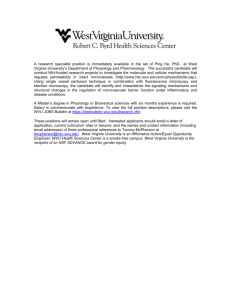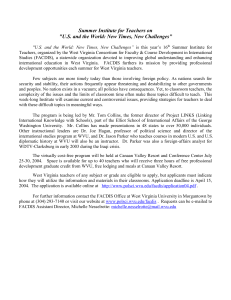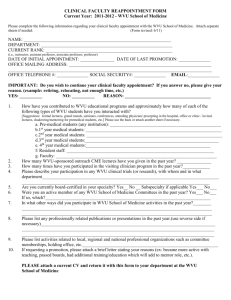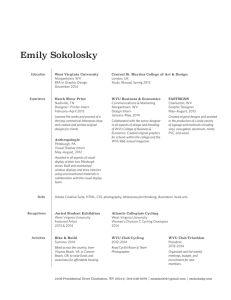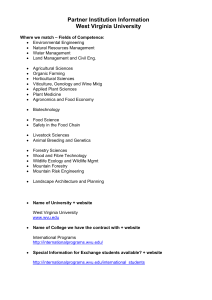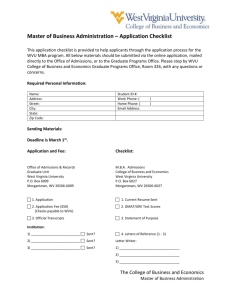Professional Development as Recruitment & Retention Strategy
advertisement
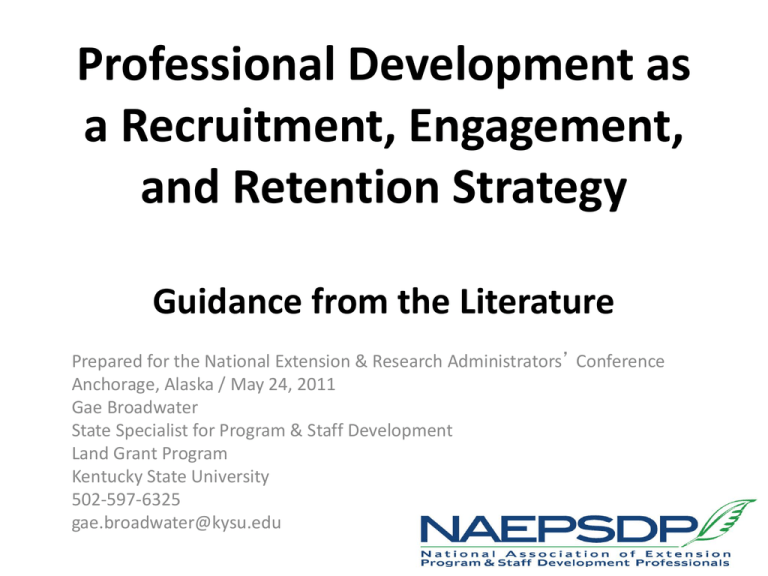
Professional Development as a Recruitment, Engagement, and Retention Strategy Guidance from the Literature Prepared for the National Extension & Research Administrators’ Conference Anchorage, Alaska / May 24, 2011 Gae Broadwater State Specialist for Program & Staff Development Land Grant Program Kentucky State University 502-597-6325 gae.broadwater@kysu.edu The Challenge • • • • • • Documented in numerous professional fields Intersects with diversity – racial, ethnic, age Diminishes effort and impact Puts investments at risk Acknowledged as universal problem Recognized by ECOP in 2005 What Employees and Former Employees Say they Want • • • • • • Emphasis on professional development Preparation for realities of job Opportunities for personal growth Career advancement opportunities Recognition for contributions Relationship building Strategies that Meet the Challenge • • • • • • • Mentoring Development Clear Expectations Feedback Innovation Engagement ERG’s – Employee Generational Groups References • Dwyer, K., and N.L. Dwyer. (2010). Managing the baby boomer brain drain: The impact of generational change on human resource management. A Change Factory White Paper, www.changefactory.com.au • Frankel, B. (2011). Why you need generational ERGs. DiversityInc.com. • Kroth, M., and Peutz, J. (2010). Workplace issues in extension. Journal of extension, 48(1). • Lynch, D., and Worden, J.M. It’s all about the people. Phi Delta Kappan, 92(3), 53-56. • Pinkovitz, W.H., Moskal, J., & Green, G. How much does your employee turnover cost? Madison, WI: UW Extension Center for Community & Economic Development. http://www.uwex.edu/ces/cced/economies/turn.cfm#calc • Safrit, R. D., and Owen, M.B. (2010). A conceptual model for retaining county extension program professionals. Journal of extension, 48(2). • Strong, R., and Harder, A. (2009). Implications of maintenance and motivation factors on extension agent turnover. Journal of extension, 47(1). Diane Craig Research Analyst University of Florida Institute of Food and Agricultural Sciences • High turnover among agents and training/ socialization deficiencies • Delphi study to determine what competencies and skills are required at key stages of early career • Revised training program • New mentoring program • New faculty guidebook Where Greatness is Learned The value of NAEPSDP National Association of Extension Program and Staff Development Professionals to the WVU Mentoring Program Pat Gruber WVU Extension Service Where Greatness is Learned Spring 2009 WVU moves forward to develop a Mentoring Program For new county faculty hires, entering positions located off campus Pat Gruber WVU Extension Service Beginning the Process • Design a Mentor Program for new county hires as an integral part of our West Virginia new faculty “Onboarding” • Identify states with mentoring programs • Identify contacts within the states Pat Gruber WVU Extension Service WVU Extension Process • Begin West Virginia new faculty interviews 35 new hires 2006-2009 interviewed First training January 2010 May 2011 54 trained mentors 35 county faculty hired between 2008-2011 have assigned mentors Pat Gruber WVU Extension Service State Contact Phone Conversations • Suggestions of process • Strengths and weaknesses • How the process flowed • Suggestions for West Virginia Pat Gruber WVU Extension Service Had there been a NAEPSDP in 2009 • Immediate group to contact • Educational opportunities related • Networking opportunities Pat Gruber WVU Extension Service If there were a NAEPSDP in 2009 I could have more easily found a positive and successful “Mentor or two” from among colleagues within our national Extension Service programs. Pat Gruber WVU Extension Service Professional Development for Extension Professionals Linda Marie Manton University of California Division of Agriculture and Natural Resources Executive Director of Staff Personnel Reorganization and Staff Development Funding Reorganization of ANR in 2010 Development of Training Coordination Training Coordination Advisory Committee Funding provided to academics and support staff Training Modules Required trainings Optional trainings Camtasia Relay Capture and Publish Their Lectures or Presentations Supports a Wide Variety of Video Formats Lecture or presentation Multiple playback devices and portable media devices Two Parts to Camtasia Relay Recorder—software program (Windows or Mac) Server—processes and publishes all presentations More About Camtasia Relay Why Camtasia? Deploy access to all of our staff and academics without individual expense Individual can download the Camtasia Recorder software on their own computer Simplicity was a key factor Record presentation without an internet connection Upload later into a formatted file to the server Professional Development to Ensure Successful Promotion and Retention of Non-Tenure Track Academic Faculty Julie N. Middleton, Ph.D. Director of Organizational Development Presented to the National Extension and Research Administrative Officers’ Conference May 24, 2011 How Does Promotion Contribute to Retention? • Communicates to employees that they are valued • Provides an incentive to remain • Facilitates career progression • Improves morale • Ensures faculty outcomes • Results in faculty feelings of success New Promotion System • Preview of first dossiers: Format was not followed. Materials were not organized. Documentation for assessing criteria was difficult to find. It was difficult to assess the true impact of body of work. Key forms were eliminated. Some faculty were modest about accomplishments. Strengths were not emphasized. Who Should Receive Professional Development for Promotion? • New faculty • Faculty employed 3 to 5 years • Faculty interested in applying for promotion • Faculty ready to participate in the promotion process • Reviewers • Promotion committee • Supervisors and other administrators Modes for Professional Development • • • • • • • Face-to-face Adobe Connect Moodle or Blackboard Statewide conferences Website (tips, resources) FAQ Open-door policy Content of Professional Development • Overview of promotion system (guidelines, process) • Factors to be considered for promotion (degree, experience) • Incentives • Factors in making decision to apply • Role of the faculty member, supervisor, committee • Criteria to be considered for promotion • Documentation required Content of Professional Development • • • • • • • • How to write an effective CV Tips for summarizing accomplishments Format of promotion packet (checklist) Selection of internal and external reviewers Mistakes often made Sample dossiers Use of technology, if appropriate Names of committee members Missouri’s Criteria I. Extension Activities (Extension Scholarship) • • • • • • Transfers or applies knowledge Documents impact Exhibits creativity and innovation Generates revenue Contributes to eXtension Engages diverse audiences Missouri’s Criteria II. Professional Activities and Service • • • • • Professional development Leadership roles and workshops Local, state or national presentations Leadership in associations University, local, state or national service Criteria: Assistant Extension Professional 1. Transfer of Knowledge and Applied Research Criteria Demonstrates excellence in transferring or applying knowledge Incorporates current and appropriate research in educational efforts Organizes, presents and implements highquality, stimulating, educational programming Produces scholarly works (traditional and non-traditional) Examples of Documentation Teaching philosophy Summary of instructional activities and role assumed Sample curricula that include latest research Samples of high-quality work Articles, publications, fact sheets, list of scholarly presentations, curricula, software, audio and video clips, PowerPoint presentations, newsletters, institutional plans or models, educational resources, websites, speeches, blogs, comprehensive reports of projects, initiatives, trainings, etc. Criteria: Assistant Extension Professional 2. Curricula Development and Program Impact Criteria Examples of Documentation Demonstrates effectiveness in program development Curricula and other programs that have been developed Learning modules Learner evaluations of programs Short-term and long-term impact data and reports Program summary report from extension web application Learner outcomes Documents significant outcomes with individuals and communities in highpriority knowledge areas/named or branded programs Criteria: Assistant Extension Professional 3. Innovation and Creativity in Teaching Techniques Criteria Examples of Documentation Applies new teaching techniques, delivery systems and learning approaches to subject matter Copies of instructional activities conducted, outlining teaching techniques and learning approaches Documentation of innovation Criteria: Assistant Extension Professional 4. Revenue Generation Criteria Examples of Documentation Secures funding or other resources to support educational programming and development; implementation and evaluation consistent with position description and responsibilities 5. Contributions to eXtension List of grants and amounts secured Fees generated through program offerings Gifts, endowments Membership in CoP Contributions to “Ask an Expert” Scholarly articles Criteria: Assistant Extension Professional 6. Engagement of Diverse Audiences as Reflected in the Community Criteria Examples of Documentation Provides educational experiences to Web Apps Affirmative Action Plan and Report audiences that represent the Demographics of program participants demographics of their community 7. Professional Activities and Service to the University Pursues continuous professional development and improvement Participates in professional service organizations utilizing position expertise Contributes to the achievement of the goals of extension, the department, college and/or university Attracts recognition by profession as leader Local conferences, seminars or other educational experiences attended; additional degrees obtained Membership in professional service organizations Documentation of contributions to goals of extension, the department, college or university Awards and other types of recognition Results Dossiers that are easy to review: • Fewer questions • Fewer requests for additional information • Strengths emphasized • Program impact apparent • Professional service readily identified • Successful recommendations at the level of the promotion committee NAEPSDP Visit the website at http://www.naepsdp.org
